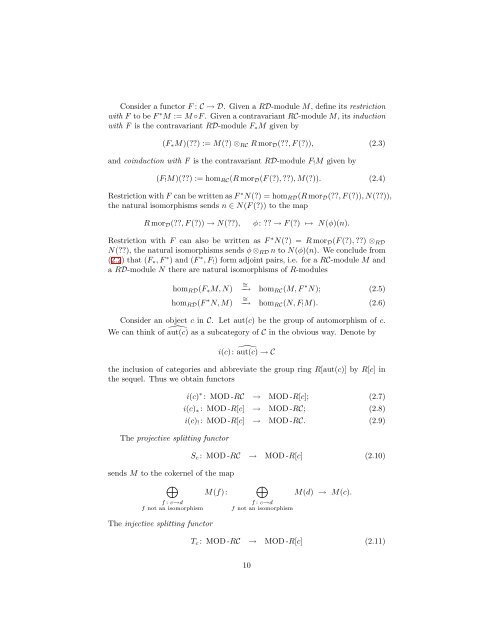Equivariant Cohomological Chern Characters
Equivariant Cohomological Chern Characters
Equivariant Cohomological Chern Characters
You also want an ePaper? Increase the reach of your titles
YUMPU automatically turns print PDFs into web optimized ePapers that Google loves.
Consider a functor F : C → D. Given a RD-module M, define its restrictionwith F to be F ∗ M := M ◦F . Given a contravariant RC-module M, its inductionwith F is the contravariant RD-module F ∗ M given by(F ∗ M)(??) := M(?) ⊗ RC R mor D (??, F (?)), (2.3)and coinduction with F is the contravariant RD-module F ! M given by(F ! M)(??) := hom RC (R mor D (F (?), ??), M(?)). (2.4)Restriction with F can be written as F ∗ N(?) = hom RD (R mor D (??, F (?)), N(??)),the natural isomorphisms sends n ∈ N(F (?)) to the mapR mor D (??, F (?)) → N(??),φ: ?? → F (?) ↦→ N(φ)(n).Restriction with F can also be written as F ∗ N(?) = R mor D (F (?), ??) ⊗ RDN(??), the natural isomorphisms sends φ ⊗ RD n to N(φ)(n). We conclude from(2.2) that (F ∗ , F ∗ ) and (F ∗ , F ! ) form adjoint pairs, i.e. for a RC-module M anda RD-module N there are natural isomorphisms of R-moduleshom RD (F ∗ M, N)hom RD (F ∗ N, M)∼ =−→ hom RC (M, F ∗ N); (2.5)∼ =−→ hom RC (N, F ! M). (2.6)Consider an object c in C. Let aut(c) be the group of automorphism of c.We can think of âut(c) as a subcategory of C in the obvious way. Denote byi(c): âut(c) → Cthe inclusion of categories and abbreviate the group ring R[aut(c)] by R[c] inthe sequel. Thus we obtain functorsThe projective splitting functorsends M to the cokernel of the map⊕M(f):f : c→df not an isomorphismThe injective splitting functori(c) ∗ : MOD -RC → MOD -R[c]; (2.7)i(c) ∗ : MOD -R[c] → MOD -RC; (2.8)i(c) ! : MOD -R[c] → MOD -RC. (2.9)S c : MOD -RC → MOD -R[c] (2.10)⊕f : c→df not an isomorphismM(d) → M(c).T c : MOD -RC → MOD -R[c] (2.11)10
















